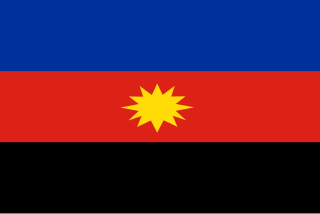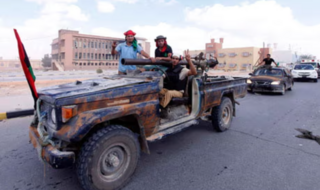
Libya's history involves its rich mix of ethnic groups, including the indigenous Berbers/Amazigh people. Amazigh have been present throughout the entire history of the country. For most of its history, Libya has been subjected to varying degrees of foreign control, from Europe, Asia, and Africa.

Sabha or Sebha is an oasis city in southwestern Libya, approximately 640 kilometres (400 mi) south of Tripoli. It was historically the capital of the Fezzan region and the Fezzan-Ghadames Military Territory and is the capital of the Sabha District. Sabha Air Base, south of the city, is a Libyan Air Force installation that is home to multiple MiG-25 aircraft.

Murzuk, Murzuq, Murzug or Merzug is an oasis town and the capital of the Murzuq District in the Fezzan region of southwest Libya. It lies on the northern edge of the Murzuq Desert, an extremely arid region of ergs or great sand dunes which is part of the greater Sahara Desert.

The Toubou or Tubu are an ethnic group native to the Tibesti Mountains that inhabit the central Sahara in northern Chad, southern Libya, northeastern Niger, and northwestern Sudan. They live either as herders and nomads or as farmers near oases. Their society is clan-based, with each clan having certain oases, pastures and wells.
The Fezzan campaign was a military campaign conducted by the National Liberation Army to take control of southwestern Libya during the Libyan Civil War. During April to June 2011, anti-Gaddafi forces gained control of most of the eastern part of the southern desert region during the Cyrenaican desert campaign. In July, Qatrun changed to anti-Gaddafi control on 17 July and back to pro-Gaddafi control on 23 July. In late August, anti- and pro-Gaddafi forces struggled for control of Sabha.

Following the end of the First Libyan Civil War, which overthrew Muammar Gaddafi, there was violence involving various militias and the new state security forces. This violence has escalated into the Second Libyan Civil War (2014–2020).

The 2012 Kufra conflict started in the aftermath of the Libyan civil war, and involved armed clashes between the Tobu and Zuwayya tribes in the Kufra area of Cyrenaica, Libya.

The Toubou Front for the Salvation of Libya is a group created in mid-2007 to defend the rights and interests of the Toubou people in Libya. It is led by Issa Abdel Majid Mansur, a Libyan Toubou tribal leader, and has its headquarters in Oslo, Norway. The group, which had participated in the Libyan Civil War on the NTC side, was disbanded in August 2011, with the fall of Tripoli. Despite that, the group was revitalized in March 2012, with the aim of "protecting the Toubou from ethnic cleansing", following early 2012 deadly clashes between Toubou and Arab militias in southern Libya, which caused the loss of hundreds of lives.
Bashir Saleh Bashir is a former aide of former Libyan leader Muammar Gaddafi. He was head of the Libyan African Portfolio, a sovereign wealth fund that invested Libya's oil wealth mostly in sub-Saharan Africa, and served as an intermediary between Libya, Africa and France. Bashir was captured after the Battle of Tripoli during the Libyan Civil War, but later escaped. Libya demanded that he be extradited because it was believed he was in France. Bashir spent Libya's oil money solely for the Gaddafi family, buying up hotels, mineral resources and shares in companies, eventually becoming what some Libyan officials and financial experts describe as one of the largest single investors in Africa. Libyan authorities believe that finding him is the key to finding a missing $7 billion in Libyan funds. He is a close associate of French businessman Jean-Yves Ollivier.

The Siege of Bani Walid was a military conflict in Libya.

Gaddafi loyalism, in a wider political and social sense also known as the Green resistance, consists of sympathetic sentiment towards the overthrown government of Muammar Gaddafi, who was killed in October 2011, and his Third International Theory. Despite Muammar Gaddafi's death, his legacy and Jamahiriya ideology still maintains a popular appeal both inside and outside Libya into the present day. Regardless, the Western sentiment has largely been that this continued support may contribute to some of the ongoing violence in Libya.

Tuareg militias of Ghat (TMG) are ethnic Tuareg tribal militias, operating in South-West Libya desert areas during the Second Libyan Civil War. The militias rose to prominence in the district of Ghat, which has a Tuareg majority. Gradually, the Tuareg forces expanded their hold also into neighbouring districts. The Libyan Tuaregs are supported by Tuaregs of Mali and groups like Ahmed al-Ansari, with support from the Misratan Libyan Dawn forces. Tuareg militias often utilize the Berber flag.
This is a detailed timeline of the Libyan civil war (2014–2020) which lasted from 2014 to 2020.

The Battle of Benghazi (2014–2017) was a major battle of the Second Libyan Civil War that raged from October 2014 to December 2017, between the Shura Council of Benghazi Revolutionaries, Islamic State of Iraq and the Levant in Libya, and the Libyan National Army (LNA), and paramilitaries supporting the Libyan National Army in the city. The battle was a direct consequence of the failed Benina Airport Offensive by the Benghazi Revolutionaries and their Allies, which allowed LNA Forces to regroup and attack deep into Benghazi.
Clashes occurred in western Libya since 14 October 2016, when a coup d'état attempt was conducted by the former head of the National Salvation Government (GNS), Khalifa al-Ghawil, against Prime Minister Fayez al-Sarraj, the head of Libya's Government of National Accord (GNA). This evolved into fighting between the GNA and GNS for control of Tripoli and parts of western Libya, while pro-GNA militias also attacked other militias for control of the region.
On 18 May 2017, an attack was launched by militia men of the town of Misrata and Benghazi Defense Brigades against the Brak al-Shati Airbase controlled by LNA forces. LNA sources claimed 141 people, including 103 soldiers and numerous civilians were killed as a result of the raid. The base was completely overrun and partially destroyed along with numerous aircraft in the base. Accusations of executions of surrendering forces led to international condemnation of GNA forces.

In late January 2019, the Libyan National Army (LNA) led by Marshal Khalifa Haftar launched an offensive to take control of the city of Sabha and the rest of southern Libya from the internationally recognised Government of National Accord (GNA) and local factions. Officially, the LNA announced that the reason for the operation was to remove terrorists, Chadian rebel groups, and to secure the border, but it has expanded Haftar's territorial control and acquired him oil fields near Sabha. It has also restarted some interethnic conflicts as the LNA has allied with local Arab tribes, while the Tuareg and Toubou tribal militias are loyal to the GNA.

The Battle of Sabha was a military confrontation in Sabha from 15 January to 4 February 2019 between the Libyan National Army (LNA) and the Government of National Accord (GNA) during the Southern Libya offensive of the Second Libyan Civil War.
The Ubari conflict was a territorial dispute between the Tuareg and Tubu tribes over control of the town of Ubari, located near the oasis town of Sabha, Libya.
Ali Kanna Sulayman is a Libyan lieutenant general of Tuareg origin. He was the commander of Muammar Gaddafi's southern forces in the First Libyan Civil War. After the end of the Fezzan campaign, he fled to Agadez and helped other Gaddafi loyalists, most notably air force commander Ali Sharif Al-Rifi, escape to Niger.











